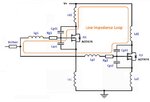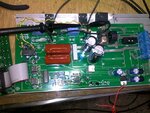anotherbrick
Full Member level 4

- Joined
- Jan 10, 2009
- Messages
- 222
- Helped
- 1
- Reputation
- 2
- Reaction score
- 1
- Trophy points
- 1,298
- Location
- Istanbul , Turkey
- Activity points
- 3,190
hello dear forum,
If I want to use parallel mosfets in a half bridge to increase output current ,
( I use IR2113 for gate drive )
the mosfets blow up in few minutes after power is ON
I suspect gate ringing becouse
I read about it in some application documents
my question ;
If I use 2 seperate gate drivers for each arm of half bridge , can I eliminate this fault ?
please look at the 2 pictures for what I mean
thank you


If I want to use parallel mosfets in a half bridge to increase output current ,
( I use IR2113 for gate drive )
the mosfets blow up in few minutes after power is ON
I suspect gate ringing becouse
I read about it in some application documents
my question ;
If I use 2 seperate gate drivers for each arm of half bridge , can I eliminate this fault ?
please look at the 2 pictures for what I mean
thank you








